Matador Network's Blog, page 1127
April 4, 2019
Ernest Hemingway museum in Cuba

US-Cuba relations might not be particularly warm these days, but Cuba is nonetheless opening a new conservation center in honor of one of America’s greatest authors: Ernest Hemingway.
Ernest Hemingway moved to his Cuban villa Finca Vigía in 1939 and lived there for over two decades during which he wrote much of A Moveable Feast, Islands in the Stream, and The Old Man and the Sea. When Hemingway urgently and reluctantly departed Cuba in 1960, he left many of his belongings behind. After his suicide in 1961, the Hemingway family donated Finca Vigía and what it contained to Cuba.
The brand new conservation center has been under construction since 2016 on the grounds of Finca Vigía, about 12 miles away from central Havana, and was inaugurated at the end of March. Finca Vigía has original furniture, artwork, and animal trophies, as well as a library of 9,000 books with margin notes from Hemingway himself, letters, telegrams, manuscripts, and more than 4,500 photographs.

Photo: LunaseeStudios/Shutterstock
Grisell Fraga, director of the museum, told AP News on Saturday, “The laboratory we’re inaugurating today is the only one in Cuba with this capacity and it will allow us to contribute to safeguarding the legacy of Ernest Hemingway in Cuba.”
The project was a result of the partnership between the Boston-based Finca Vigía Foundation and Cuba’s National Cultural Heritage Council, with the grand opening attended by Massachusetts Congressman Jim McGovern. “When we come together,” he said, “when we work together, we can do positive and amazing things.” 
H/T: Lonely Planet

More like this: What it’s like traveling to Cuba as a Cuban American
The post Ernest Hemingway’s legacy preserved in a new center in Havana, Cuba appeared first on Matador Network.

New TSA machines to detect laptops

Travelers might finally be getting a break from the ever-frustrating airport security rules. Thanks to the introduction of new carry-on baggage scanners called CT (Computed Tomography), travelers won’t have to take electronics or liquids out of their bags. The TSA announced the rollout of this new technology, which would ultimately cut down on long security lines and make the airport experience much smoother.
The new machines can create 3D images of a bag’s contents and automatically detect and scan items you are currently required to remove. This includes electronic devices like laptops, and even liquids. According to Bloomberg Government, 300 of these new machines have been ordered by the TSA so far, and they will begin to appear in airports this summer. Eventually, the goal is to replace all current X-ray machines with these new CT scanners. The TSA has been testing these machines since 2017, and once airport employees become comfortable operating the new equipment, shorter security lines are expected.
The list of airports that will receive the new CT machines has not yet been released, though they are currently being used at the following airports:
Hartsfield-Jackson Atlanta International Airport (ATL)
Baltimore-Washington International Airport (BWI)
Chicago O’Hare International Airport (ORD)
Cincinnati/Northern Kentucky International Airport (CVG)
Detroit Metropolitan Wayne County Airport (DTW)
Houston Hobby Airport (HOU)
Indianapolis International Airport (IND)
John F. Kennedy International Airport (JFK)
Logan International Airport (BOS)
Los Angeles International Airport (LAX)
Oakland International Airport (OAK)
Phoenix Sky Harbor International Airport (PHX)
St. Louis Lambert International Airport (STL)
Washington-Dulles International Airport (IAD)

H/T: Thrillist

More like this: All of the food you can’t take through airport security
The post New TSA technology will let you keep laptops and liquids in your bags appeared first on Matador Network.

How to visit Chernobyl, Ukraine

Chernobyl’s Exclusion Zone, the quarantined area surrounding the power plant where one of the worst nuclear disasters in history took place, sees way more traffic than the name might suggest. Since the site opened to visitors in 2011, a growing number of tourists have come to northern Ukraine armed with cameras and Geiger radiation counters to visit the rusting remains of the ghost city of Pripyat. It is estimated that in 2017 alone 50,000 people visited the area that was evacuated after the No. 4 reactor explosion, a number three times greater than in 2015. Traveling to Chernobyl today is easier and safer than one might think, with tours departing daily from the capital city of Kiev and infrastructure set up to welcome tourists in the somber Soviet wasteland that was left abandoned after 1986.
What happened in Chernobyl

Photo: Angelo Zinna
The Chernobyl nuclear power plant consisted of four reactors built between 1970 and 1983 (with two more under construction at the time of the accident), located about 110 miles from the capital city of Kiev. Due to a failed test that was meant to determine how turbines would react to an electricity blackout, on April 26, 1986, the No. 4 reactor at the power plant exploded causing what is considered to be one of the most disastrous nuclear accidents in history.
When the lid of the reactor blew off, vast amounts of radioactive materials were released into the atmosphere. The settlement of Pripyat, a town of 49,000 inhabitants built especially to house Chernobyl’s workers and their families, was the first to be evacuated. According to the World Nuclear Association, in 1986, about 116,000 people were evacuated from areas surrounding the reactor (an area now known as the Chernobyl Exclusion Zone, today a military-controlled ring with a 19-mile radius from the power plant); after 1986, about 220,000 people had to leave from Belarus, the Russian Federation, and Ukraine. 30 employees of the power plant and firemen died within a few days or weeks of the accident, and 28 of them suffered from acute radiation syndrome.
Chernobyl today
Today, nature has repossessed the Exclusion Zone and where Pripyat once stood, and a collection of dreary, abandoned buildings filled with rubble have become an unusual attraction. Twenty-five years after the accident, in 2011, Chernobyl opened to visitors after a number of safe itineraries were traced. Since then, a steady stream of tourists have reached the 10-kilometer zone, the inner area which suffered the most from contamination. Although the 1,000-square-mile Exclusion Zone remains quarantined and policed by guards who allow access only to those in possession of a special permit, a small group has chosen to stubbornly return to their original homes. In 2015, The Guardian claimed that 130 people lived in the CEZ; many of them returned to their homes soon after the nuclear accident, unafraid of the invisible nuclear hazard and unwilling to go through the trauma of relocation.

In the background, the New Safe Confinement shelter covering the No. 4 reactor. (Photo: Angelo Zinna)
In 2017, the New Safe Confinement shelter (a huge steel structure) was placed on top of the No. 4 reactor to protect the region from contamination for the next century. The first reactor was operational until 1996, the second shut down in 1991, and the third kept running until the end of 2000. Since then, Chernobyl has remained dormant.
But the Chernobyl Exclusion Zone is much more than a magnet for dark tourists. According to National Geographic, the area has become a unique wildlife sanctuary. Researchers from European universities have been studying animal life in the contaminated area, noticing a substantial increase in the population of different species of large mammals. Boars, wolves, bison, raccoon dogs, foxes, and Przewalski’s horses inhabit the area today, offering insight into the long-term effects of radiation exposure and human-free habitat.
While the fauna may appear to be thriving in a hostile environment and small groups of people are going back to abandoned villages, in 2005, the World Health Organization estimated that 4,000 people could eventually die because of the radiation produced by the nuclear explosion.
Visiting the Chernobyl Exclusion Zone

Photo: Angelo Zinna
Although there are reports of people breaking into the perimeter of the CEZ, the only legal and safe way to see what is left of Pripyat and its surroundings is through a licensed tour. While the levels of radioactivity on the prescribed routes are within the limits of safety (at times even lower than in Kiev), hotspots are still present, making a guide who knows the area absolutely essential. Group tours depart daily from Kiev, but it is also possible to rent a guide for private or multi-day trips.
A visit to Chernobyl typically begins with obtaining a permit, which is easily done via travel agents when booking a tour at least two days before departure. A two-hour drive leads to the Dytyatky checkpoint at the entrance of the CEZ, where you will be asked to show your passport. Companies require tourists to wear long sleeves, trousers, and closed shoes, and it is forbidden to touch or remove anything from the area.
Day tours with SoloEast Travel usually last between 10 and 12 hours and stop in small abandoned villages such as Cherevach and Zalissya before reaching the second checkpoint that allows entry to the 10-kilometer zone. The buildings, cars, and roads of these disappearing hamlets are being swallowed entirely by the flora. Before reaching Pripyat, the highlight of any visit to Chernobyl, the tour will take you outside the 35,000-ton steel encasement that covers the No. 4 reactor, showing from a distance the site where the explosion took place.

Photo: Angelo Zinna
In what is left of Pripyat, vegetation is, at first glance, the only indication that time has passed. Restaurants, schools, and housing blocks stand grimly among tall trees and rusting streets lamps. Although entering the buildings has been prohibited since 2012, guides do take groups inside gyms, kindergartens, and the hospital, and the impact of mass tourism in these eerie spaces is clearly perceptible. A few steps inside the decaying classrooms are enough to understand that gas masks and rotting dolls are placed in a way-too-photogenic position to have been left like that by panicking evacuees.

Photo: Angelo Zinna
A sea of gas masks, allegedly kept under the student’s desks during the Cold War in case of a nuclear attack, covers the floor of one of the classrooms. On a row of chairs placed parallel to the wall, stuffed bears and broken dolls sit in a creepily ordered fashion. Propaganda posters decorate the spaces while plaster crumbles. Pripyat’s interiors remind us that the city may be less ghostly than what it appears to be from the outside. That said, the Instagram-friendly compositions do not render the experience less fascinating. Imagining that 49,000 people lived here unworried until the fateful day is still chilling.

Photo: Angelo Zinna
Most tours include a visit to the Duga Radar, a huge metal structure hidden deep in Chernobyl’s forest, built by the Soviet Union to intercept long-range missile threats coming from the West. Erected in 1972, the 492-foot-tall secret station became known as the Russian Woodpecker because of the repetitive sound emitted from the radar. Upon discovery of the Duga, a defense weapon that never truly worked but is said to have cost more than the power plant itself, conspiracy theories started circulating. The radar was described as a mind control system created to influence Americans, but was never much more than a gigantic waste of steel.
Before exiting the CEZ, you will have to go through a radiation check. Scanners are placed at the checkpoints on the road to Kiev and will detect traces of radiation that you may have come into contact with.
Know before you go
Visiting Chernobyl is safe. The radiation levels in most areas surrounding the power plant are comparable to the natural background radiation found all around us. While there are some dangerous hotspots, you will not be taken there.
SoloEast offers day tours to Chernobyl from Kiev starting at $81, going up in the hundreds for overnight or private trips. Some companies, such as CHERNOBYLwel.come, offer excursions inside the power plant as well. People under the age of 18 are not allowed inside the Chernobyl Exclusion Zone. 

More like this: 9 fascinating examples of Soviet-era architecture
The post How to visit Chernobyl safely and legally appeared first on Matador Network.

Outdoor yoga with lemurs

2019 is shaping up to be the year of strange yoga practices. After rage yoga (a way of achieving a state of calm and getting a good workout by cursing, shouting, and boozing it up) and alpaca yoga (practicing yoga with alpacas outdoors), lemur yoga is the newest offering. Armathwaite Hall Hotel and Spa, a four-star hotel in England’s Lake District, offers “Lemoga Spa Breaks,” a wellness package that includes a spa treatment, overnight accommodation, and among others, yoga with the lemurs from the nearby wildlife park.

Photo: Armathwaite Hall Hotel and Spa
Richard Robinson, manager of the Lake District Wildlife Park, told the BBC, “When you watch lemurs they do some form of the poses naturally — that typical pose warming their bellies in the sunshine. It seemed to be a really good combination to encourage people to have a go and spend time with a lemur.” He added that “we spend all our time with animals. We know how it makes us feel and if we can give a little piece of that to people then great.”
Having fun with these cute primates doesn’t come cheap, however. The “Lemoga Spa Break” starts at $649 for two people.
The good news is that you don’t have to partake in lemur yoga to enjoy the company of the animals. The Lake District Wildlife Park gives visitors the chance to “buy an experience” with animals such as walking alpacas, meeting and feeding meerkats, grooming and feeding a tapir, and encountering lemurs for a lot cheaper ($65.50 per person). 
H/T: Travel & Leisure

More like this: 10 must-haves for the traveling yogi
The post Find inner peace by doing some lemur yoga at this hotel in England appeared first on Matador Network.

April 3, 2019
The best family volunteer trips

While taking a family vacation is nothing new, family volunteer trips are becoming a more popular way to travel. Volunteer trips allow families to experience new countries and cultures while bonding as they complete community-oriented tasks. Parents find that these trips can create awareness about other parts of the world and instill in their children the value of service and giving back. Through volunteering abroad, you can experience life as a local and contribute to a meaningful cause.
You can choose from many locations around the world and specific volunteer tasks, but it does depend on the physical ability and age of each family member. Family volunteering opportunities usually focus on wildlife/marine conservation, teaching English, helping out at a farm, or various activities at a local orphanage.
If you’re interested in taking a volunteer trip with your family, do some research on the organization you choose to find out what it stands for and what it’s trying to achieve. You might also consider reviews left by other families and what types of meals, lodging, and transportation are included in the price. These trips can range from inexpensive — with shared, rustic accommodations — to more comfortable and pricey.
Time frames for each trip vary, but they are usually about a week of volunteer work with weekends left open as free time to explore the area. GoEco, Volunteer World, and United Planet are just some of the organizations that help coordinate these types of trips. Here are seven ideas for sustainable family volunteer excursions.
1. Volunteer at Elephant Forest Refuge — Chang Rai, Thailand

Photo: Koen Vrints/Shutterstock
This is a great option for families with children of any age who love animals and are looking for up-close encounters with rescued elephants. Organized through GoEco, the Elephant Forest Refuge in Thailand prides itself on its ethical values and treatment of the animals. Families would be observing the elephants’ behavior and environment, helping to feed them, and assisting in developing the support structures that surround the elephants.
2. Service and safari — Moshi, Tanzania

Photo: Suntichai Boottasen/Shutterstock
Families can have the best of both worlds with this volunteer trip organized through Elevate Destinations. The Make A Difference (MAD) organization partners with a local orphanage in Moshi, Tanzania. The first part of your trip would be to volunteer at this center/school for disadvantaged children by helping out in a variety of ways. Families can help children learn to read, teach them new games/sports, help with the garden, assist in the repair of beds and desks, paint, and teach music/art/drama. After the week spent working with kids, families will take a customizable multi-day safari adventure in Tarangire National Park and Serengeti National Park.
3. Help at Giant Panda Center — Chengdu, China

Photo: leungchopan/Shutterstock
This wildlife experience, which you can organize via GoEco, allows for families with children at least 12 years old to participate in learning more about and caring for pandas. Thanks to the efforts of the Giant Panda Conservation and Research Center in Chengdu, China, the animal is no longer on the endangered species list. Volunteers will be paired with a trainer and likely prepare food for the pandas, chop and carry bamboo, clean panda enclosures, and participate in observations. Because pandas are still considered vulnerable species, much effort continues to go into this program to help protect the future of the giant panda.
4. Volunteer with turtles — Bay of Kyparissia, Greece

Photo: PitK/Shutterstock
In this environmentally oriented opportunity, which you can arrange through GVI, you can help an endangered species while also enjoying time on Greece’s lovely Peloponnesian coastline. Families can sign up to help safeguard sea turtles and their breeding sites all while helping to promote the United Nations Sustainable Development Goals. Families will be involved in the daily monitoring of the female loggerhead turtles nests. Once the nest has been located, your family will be tasked with protecting it from predators and incoming water due to tide changes. This volunteer effort also creates awareness in the local communities, which then helps to increase their overall protection. Families will be camping in tents right by the cool Mediterranean sea and have the opportunity to explore the Greek culture and towns during their free time.
5. Education and community work — Bali, Indonesia

Photo: Maks Ershov/Shutterstock
This community-oriented trip, organized through GoEco and set in the lovely tropical island of Bali, allows for your choice of teaching kindergarten, construction, or health education to the villagers in Ubud. What makes this option so special is that families with children as young as five are welcome to volunteer in the kindergarten program. There, they would be helping to plan simple lessons and teaching basic English phrases using songs, games, and arts and crafts. Other options for families with older kids would include teaching village children the importance of personal health and hygiene or helping to renovate/repair existing buildings. You would stay in shared accommodations, although families with young kids stay in private accommodations.
6. Sustainable community projects — Capetown, South Africa

Photo: wolffpower/Shutterstock
Families in this volunteer program through GoEco would have a choice as to what type of educational setting they would be assisting in. Depending on the age of children, families can choose to volunteer at settlement project care centers, where they would be assisting with vegetable gardens, everyday operations, and organizing sports activities for the disadvantaged families who live in the area. Another option would be helping to teach some classes or generally assisting teachers in the community pre-schools or at a farm school in Capetown.
7. Whale shark and marine conservation — Placencia, Belize
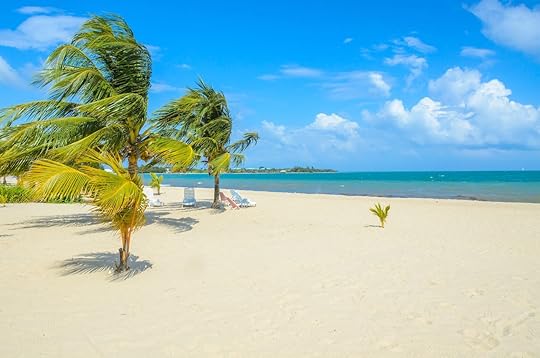
Photo: Simon Dannhauer/Shutterstock
While you are not guaranteed to swim with a whale shark on this trip, which you can book through Volunteer World, it is a real possibility. Families with children at least 16 years old will become part of an active marine research team with ReefCI. Possible activities include whale shark observation, lobster and queen conch surveys, data collection of coral bleaching areas, reef habitat surveys, and fish and coral identification dives. Diving certification courses are offered on the island, and some e-learning specialty courses can be taken ahead of time. 

More like this: 3 reputable elephant sanctuaries in Thailand
The post 7 sustainable volunteer trips you can actually take the family on appeared first on Matador Network.

The best LGBTQ travel companies

As a queer traveler, planning a vacation that will be equal parts captivating and safe can prove to be incredibly difficult. And, while it may have seemed like a far-off dream just a few decades ago, there are now, with just the click of a button, a plethora of LGBTQ travel companies offering an endless array of pre-planned trips and tailormade adventures for every traveler in the rainbow.
Whether you’re looking for a chance to meet fellow queer nomads or just desire a luxurious, exhilarating vacation without the stress of extensive planning, these are the LGBTQ travel companies that specialize in providing the most engaging and memorable vacations you’ll ever embark upon. These are the queer companies that can help you plan your next vacation.
1. Detours Travel

Photo: Detours – Gay Group Travel/Facebook
Unlike other travel groups with detailed itineraries and 50-person tour buses, Detours Travel allows its travelers to plan their own excursions while on trips offered around the world, which include South Africa, New Zealand, Greece, Costa Rica, and Thailand. In essence, this travel group prides itself on offering organized trips with like-minded and accepting people to adventurous locales. Detours Travel believes in fully immersing travelers in a new culture without the fear of facing international crowds that may not be as accepting as those back home.
2. RSVP Vacations
For those specifically interested in LGBTQ cruises, RSVP Vacations promises to deliver a truly thrilling experience aboard a cruise ship explorating one of various routes. While aboard an RSVP Vacations cruise ship, thousands of LGBTQ guests are guaranteed the opportunity to participate in a number of different queer-themed activities that range from raucous games of Bingo to performances by gay entertainers. No matter where you belong in the LGBTQIA+ community, RSVP Vacations provides a welcoming and fun community for all of its passengers.
3. OUTstanding Travel

Photo: OUTstanding Travel/Facebook
Specifically specializing in gay Mediterranean Travel, aptly named OUTstanding Travel offers tailored outings to locations like Israel, Greece, Jordan, Italy, Egypt, and Spain. OUTstanding Travel, created by local queer people, truly delivers on providing unforgettable vacations for gay men and their travel companions, especially for those looking to get a true taste of the culture, cuisine, and nightlife of their Mediterranean bucket-list destinations. Not only that, this travel agency caters to larger groups of queer people, meaning that you’ll also have the ability to network and connect with other like-minded nomads.
4. TropOut
TropOut is a gay travel agency created to dazzle and ignite the curiosities of 21st-century queer travelers — just be prepared to dance and party your way through this vacation. Each year, this gay travel agency plans a large organized trip to one special locale (next year, they’re headed to Phuket, Thailand). No matter where they’re headed, though, there are a few trip mainstays — like private yachts, beachside partying, and adventurous excursions that will inevitably force travelers out of their shell and encourage them to meet new people from all over the world. If you’re looking to make lifelong friends during your next international vacation, consider perhaps trying on TropOut for size.
5. OUT Adventures

Photo: Out Adventures/Facebook
For nearly a decade, OUT Adventures has been the premier provider of exclusive cruises, gay tours, and gay travel. If you’re looking to head to more remote locales (in addition to the more typical vacation destinations), then OUT Adventures is the gay travel agency for you, offering thrilling excursions to Nepal, Antarctica, Kenya, and Vietnam. Not only that, but you also have the ability to go on themed LGBTQ-friendly adventures — whether you desire a vacation that revolves around getting those miles in on your bicycle or one that has an emphasis on architecture and drinking copious amounts of wine.
6. HE Travel
Despite its name, HE Travel caters to every member of the LGBTQIA+ community. And, more so than any other travel group on the list, it provides an impressive number of outings on every single continent — even Antarctica. While on these excursions around the world, you’ll be in constant contact with a small group of travelers put together by the touring company — this way, you’ll have travel companions and possibly, by the end of the trip, lifelong friends. For the past 40 years, this travel agency has garnered an impressive amount of praise for planning tours that bring customers to the very core of every culture that they encounter, along with developing tour excursions that promote being kind to the environment.
7. Oscar Wilde Tours

Photo: Oscar Wilde Tours/Facebook
If you’re interested in LGBTQ history, take a look at Oscar Wilde Tours. Created by professor Andrew Lear, a gay history scholar, this travel agency curates vacations that will allow its travelers to fully immerse themselves in the history of their people — from Sappho to Oscar Wilde. The agency offers historical LGBTQ tours in many major cities, like New York City, London, Amsterdam, and Berlin, guaranteed to leave each traveler with a true sense of the history of their people in the most beautiful places on Earth.
8. VentureOut
If your desire is to travel to a foreign country with 12-14 of your closest LGBTQ friends, then VentureOut is the travel agency to fit your needs. Currently, the group offers planned excursions to Spain, Italy, Malta, Scotland, southern Africa, and Japan. Aside from having the opportunity to cross even more destinations off your bucket list, VentureOut provides cultural and historical tours, nature trips, cruises, and wildlife safaris that allow its travelers to tour their destination in whatever way they wish, whether they want to do so in a more adventurous or casual fashion.
9. Pink Iceland
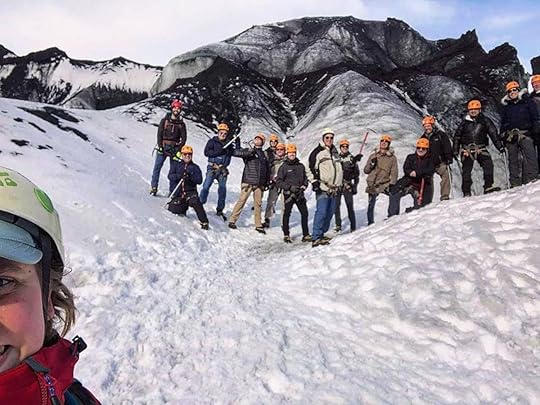
Photo: Pink Iceland/Facebook
If you’re hoping to travel to Iceland sometime in the not-so-distant future, consider Pink Iceland to be your quintessential insider to the best and brightest that this country has to offer to its LGBTQ tourists. Pink Iceland is a travel agency that specializes in day tours, weddings, international and domestic events, festivals, and tailor-made luxury travel as it pertains to the LGBTQ traveler. Not only that, but Pink Iceland is also embedded in Iceland’s LGBTQ culture, which enables the company to provide a truly intimate look at every corner of the country, from happy hours to rugged hikes through the most beautiful parts of Iceland.
10. Pied Piper Travel
More so than any other LGBTQ cruise company, Pied Piper Travel works to offer lots of cruise options that appeal to every kind of queer traveler. From admiring the icy tundras of Antarctica to diving into the beautiful Greek Isles, Pied Piper Travel seeks to explore the world’s most beautiful destinations aboard a line of luxurious cruise ships. For those traveling with larger groups, the travel agency also gives you the option of booking private excursions off the ship and group events while still onboard. In this sense, it pays to bring all of your friends aboard this unique cruise line.
11. Olivia Lesbian Travel

Photo: Olivia Travel/Facebook
Calling all lesbian travelers: Olivia Lesbian Travel is a travel company that specifically curates international adventures for lesbians from all walks of life. From all-inclusive cruises to beachside resorts and adventurous escapades like African safaris and hikes through the jungle, this travel agency aims to plan an unforgettable experience for yourself and other lesbian travelers just like you. No matter which side of the globe you have yet to explore, Olivia Lesbian Travel will open you up to new possibilities and exciting cultures in destinations like Tulum, Prague, and Zurich.
12. Zoom Vacations
As the winner of numerous travel industry accolades, it’s clear to see that Zoom Vacations, a travel agency that specializes in LGBTQ travel, provides some of the most memorable excursions that the world has to offer. Unlike other travel groups, Zoom Vacations finds a way to immerse its clients fully in the culture of their chosen locale — whether that means that you’ll be cooking in the private home of the most famous chef in Brazil or getting blessed by a real Inca shaman in a temple of Machu Picchu. Along the same lines, it’s safe to assume that as a client of Zoom Vacations every aspect of your travels — from the hotels to the meals — will be at truly exciting destinations. 

More like this: 11 must-see lesbian historical destinations
The post 12 queer companies that can help you plan your next vacation appeared first on Matador Network.

Newest airports in the United States

No nation loves to complain quite like the United States. Even though we’ve got people from all over the world trying to move here every day, we’ll still take to social media any chance we get to gripe about everything from slow pizza delivery drivers to overpriced coffee.
But nobody gets the brunt of the complaints like airports.
Travel abroad and you’ll find airports that feel like brand new shopping malls. Technological palaces with butterfly gardens, movie theaters, and outdoor meditation spaces. You’ll find wide concourses, floor-to-ceiling windows, and automated everything.
Back home you wait on needlessly long security lines, only to find no seats at your gate because your airport was built in the ‘70s when, like, 12 people a day were taking planes.
Even with better food and craft beer bars, America’s airport experience is at best tolerable. All of our major airports were built before 9/11, which in aviation terms would be like having a computer from before the internet. Security is tighter, but security-lane capacity hasn’t kept up. We spend more time in airports now, but many terminals are from a time when airport amenities didn’t need to be much more than a pretzel stand.
And let’s not even get started with the lines at customs and immigration.
The flying public has asked airports to do more and given them nothing to do it with. We sent 888 million passengers onto US airlines last year, in facilities designed for less than half that load.
So why is the nation that invented flight so far behind on building new facilities? And what are we doing to address the national airport crunch? It seems, at the very least, there might be a light at the end of the proverbial runway.
Building an airport isn’t like building a shopping mall.

Photo: Martin Valigursky/Shutterstock
Building an airport might be the most complicated public works project imaginable. In addition to the usual hurdles of land access and environmental regulation, you need to conduct noise impact studies. You need to coordinate local, state, and federal organizations, as well as major corporations. You need to plan for traffic and public transportation. It is neither easy nor cheap, and it’s a civic undertaking ill-suited to modern American cities.
That’s because most modern cities don’t have land to devote to an airport. At least one that would be convenient enough for most of its residents. The alternative, then, is to build a new airport where land is available, typically a long, unpleasant drive from the city center. Denver, for example, has the newest airport in America and also one of the furthest from the city, nearly 26 miles on I-70. No US city is in a position to devote prime real estate to a new airport, so building anything new would replace the inconveniences of the old airport with the inconvenience of getting to the new one.
Airports are also expensive. Mexico City recently halted construction of its new airport, tagged at $13 billion. That would likely cost even more in the US where labor costs are higher. Paying for it isn’t just a matter of allocating city funds. Airports have intense restrictions on how they can be funded, making it difficult for governments to get creative with financing.
Some improvements and construction are financed by the Passenger Facilities Charge, a $4.50 tax added onto each flight segment. Congress hasn’t raised that since 2001, though it was an oft-cited solution for our airport woes earlier this decade. Most new airports are financed by the issuance of revenue bonds, which the airlines often back. That means the airlines have influence over where airports go, and they don’t want them out in BFE.
These are all highly simplified explanations for a vastly complicated issue — but essentially the combination of government rules, lack of money, and lack of desirable space makes very slim the prospect of any new airports in the US any time soon.
So if we can’t build new airports, what can we do?

Photo: EQRoy/Shutterstock
Part of the reason airports haven’t been able to expand is that the money wasn’t there. Most 1970s-era airports were due for big upgrades towards the end of the 20th century. Then 9/11 happened, and airlines we in no position to spend money on fancy new terminals.
The end of that decade saw the financial collapse of 2008-2009, which again shoved airport upgrades to the bottom of our nation’s priority list. But now, after nearly a decade of growth, airlines and investors are ready to put some money into our airports.
Seattle, which this year cracked the top 50 busiest airports in the world and now ranks ahead of Las Vegas, Orlando, and Miami, opened a new privately funded airport north of the city in Snohomish County called Payne Field. It runs 18 flights a day on Alaska Airlines to west coast destinations, with United Airlines joining them this month. It’s meant to ease the burden of domestic traffic at Sea-Tac and may be a model for beleaguered, single-airport cities in the future.
But the bulk of the $10 billion US airports will be spending each year, according to Airports Council International — North America, will be on large scale upgrades.
The $4 billion renovation at New York La Guardia created a traffic nightmare for New Yorkers but will effectively rebuild the Delta terminal in an airport former Vice President Joe Biden once described as something out of “a third world country.”
Salt Lake City is in the midst of a $3.6 billion “renovation” that will bring a new two-terminal site to aging SLC. It is, in effect, an entirely new airport built on the old airport’s site. The same thing is happening in New Orleans, where a new billion-dollar terminal will open next year replacing the aging one at Louis Armstrong International. No new name or runway but effectively a whole new facility.
LAX is partnering with American Airlines to re-create Terminals 4 and 5, giving them, among other things, easy access to the airport’s badly needed automated people mover, post-security connectors between terminals and easy access to the Tom Bradley International terminal. The new terminals will also have vastly increased security space, streamlined paths from check-in to security, and an emphasis on natural light.
Chicago O’Hare is in the process of reconfiguring its runways into a parallel design to reduce airplane traffic and adding four more runways to increase capacity. Boston Logan and Denver have also added gates to increase capacity, as well as made terminal improvements.
Nearly every airport in the US is doing some kind of terminal renovation, and they’ve added plenty of automation, like check-in kiosks and APC terminals at passport control to help things move more quickly. They might not have the TV appeal of a ribbon-cutting in Guangzhou, but they’re getting the job done. Most of the projects underway now should be done by the middle of the next decade or slightly after. So despite our growing pains, US airports may catch up to the world sooner than you think. 

More like this: The best (and worst) airline food in the world, according to a pro airline food reviewer
The post Why America hasn’t built any new airports in 24 years, and what we’re doing to handle the traffic appeared first on Matador Network.

California national parks must-sees
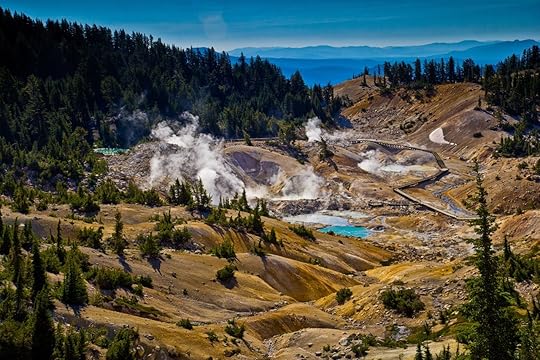
California is pretty mind-blowing. Within a few hours, you can explore some combination of incredible landscapes — from rugged coastlines and jagged mountains to lush forests, dark caves, or captivating deserts. The fact is, the Golden State has some of the country’s most stunning and unique scenery. It’s no wonder that it has more national parks than any other state. But deciding which of California’s nine parks to visit can be tough. We’ll help you decide by listing the single best things about each park. For good measure, we’ll include the top things to do at all of them, as well.
Yosemite National Park: jaw-dropping views
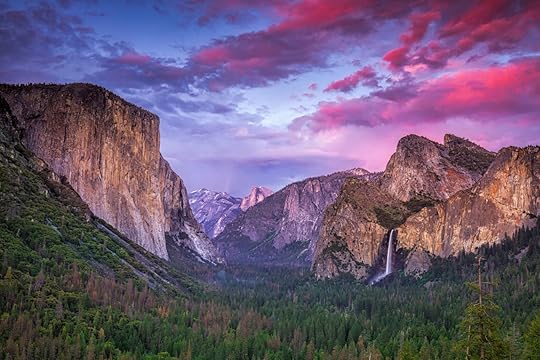
Photo: Andrew S/Shutterstock
Yosemite National Park is one of the most majestic and iconic parks in the US. Located in northern California’s Sierra Nevada range, Yosemite is probably best known for its granite cliffs of Half Dome and El Capitan, the world’s largest granite monolith. In fact, standing near the base of El Cap and gazing up at the site of Alex Honnold’s incomprehensible climb, memorialized in the Oscar-winning Free Solo, is one of the best things about Yosemite.
But there’s something that tops even that. It’s the sweeping vista of the entire Yosemite Valley, made famous by Ansel Adams’s black and white photographs, a sight everyone should savor at least once. The best place to catch this view — which includes El Cap, Half Dome in the distance, and Bridalveil Falls — is from the Tunnel View point.
After you’ve crossed the iconic vista from your top 10 bucket list, head into the valley to take in some of Yosemite’s other incredible highlights. At any time of year, this will involve braving tourist crowds — so get an early start each morning. Many of the trails in Yosemite Valley are gentle flat trails that lead directly to top attractions. Popular hikes include Tuolumne Meadows and Mariposa Grove, where you can walk through a massive sequoia forest. On Southside Drive, short trails lead to Bridalveil Fall and the Sentinel Bridge, another spot for Half Dome views. If you’re hardy hikers with sturdy shoes, the Yosemite Falls hike takes you three miles steeply uphill — and then you have to head back down.
Pinnacles National Park: fascinating geology
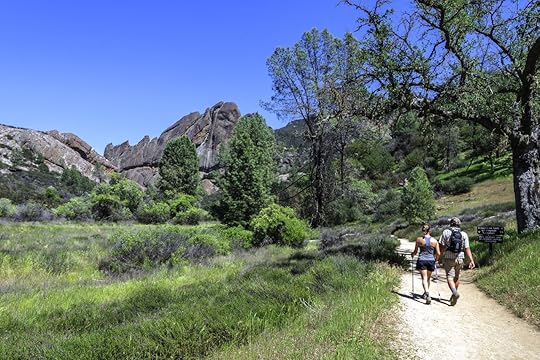
Photo: randy andy/Shutterstock
The newest of all the California national parks is Pinnacles. Designated a national park in 2013, Pinnacles is about an hour away from Monterey County. It gets its name from the huge domed spires that were created out of the volcanic activity — and it’s this very unusual geology that is the most special thing about this park. In addition to the photogenic spires, the park has two caves that you can hike through and that house local bat species.
The second best thing about pinnacles is that it’s home to condors, regal birds whose wingspans reach nearly 10 feet across. Since condors don’t migrate, you can see them from certain viewpoints all year. You can catch them while hiking, and two paths we recommend are the Moses Spring Trail and Bear Gulch Cave Trail. Both treks take you to caves and offer views of the volcanic structures. Rock climbing is also very popular on the west side of the park, and there are routes for beginners and advanced climbers alike. This park is one of the least-visited in California, another bonus if you don’t enjoy the crowds. The park only has one campground, which is busiest in the spring and fall months, when temperatures are milder.
Joshua Tree National Park: whimsical landscape

Photo: Dejan Stanisavljevic/Shutterstock
Joshua Tree National Park, located just two hours outside of Los Angeles, is beloved for its namesake Joshua trees. The Dr. Seussian plants are not actually trees but yucca plants. The desert’s unique landscape of high Mojave desert meeting low Colorado desert, combined with mountains and valleys, make this national park a place of stark contrast. Add in the magical Joshua Trees, and you have an almost mystical aura that is found only here — which is the most notable feature of this park.
Popular hikes here include Indian Cove Natural Trail, a great place to see the Joshua trees, and Cholla Cactus Garden, where you can see a dense concentration of cactus plants. Joshua Tree National Park also has huge boulders that have become a rock climbers’ paradise. You can scramble some of the smaller boulders on Arch Rock Trail or watch the rock climbers at Echo Cove. For sweeping views of the valleys and nearby peaks, head to Keys View, the highest point at Joshua Tree National Park.
Redwood National Park: the tallest trees in the world

Photo: Chiyacat/Shutterstock
The famed redwood trees that grow along California’s northern coast are simply astonishing, and they’re the number one reason to visit this park. These trees can grow upwards of 350 feet tall; looking up at them can take your breath away. Redwood National Park is actually a huge area that contains a clustered network of three state parks, Prairie Creek, Jedediah Smith, and Del Norte. The most popular hike in the area is Fern Canyon, which was actually a filming location for Jurassic Park 2. Walking through this densely forested canyon does make you feel like you’ve stepped back in time.
Tall Trees Grove is where the tallest of the redwoods reside. Getting here requires a free permit from Kuchel Visitor Center, which helps to keep the number of visitors to a minimum. This area is also known as prime kayaking, mountain biking, river fishing, and horseback riding location. Several tour companies take visitors on half-day or full-day excursions to show them the beauty of the North Coast.
Death Valley National Park: stunning desert

Photo: Doug Lemke/Shutterstock
Death Valley is a land of extremes. It holds the record for the hottest temperature in the world, 136 degrees Fahrenheit, and is the driest place in North America, seeing an average of two inches of rainfall a year. But the most remarkable thing about Death Valley isn’t its record-beating heat. Rather, it’s the startling, eerie beauty that one would hardly expect in such a harsh and arid environment.
If you’d like to see all the shades of yellow and orange against the golden cliffs, then you must drive up to Zabriskie Point or hike the two-mile Golden Canyon for views of the sunrise or sunset. Another must-see is the Badwater area, which is the location of America’s lowest point at 282 feet below sea level. A drive down Badwater Road lets you see the salt flats and puddles, which are all that remain of an ancient dried up lake. A walk through the Mesquite sand dunes offers a chance to see some wildlife, like a coyote or a desert fox. For another unique hike, check out Ubehebe Crater, where you can walk along the rim of an ancient volcano.
Sequoia National Park and Kings Canyon National Park: the largest trees in the world by volume

Photo: welcomia/Shutterstock
Sequoia and Kings Canyon National Park are technically two parks, yet they’re administered jointly. Located just 75 miles south of Yosemite, they’re often overlooked in favor of their famed southern neighbor. Yet that fact is one of the top reasons to visit the parks. While they share much of the same topography, flora, and fauna of Yosemite, they don’t get the same throngs. You can gaze at soaring granite formations like Grand Sentinel while on a serene, uncrowded walk through Kings Canyon’s Zumwalt Meadows.
That said, the number one thing about these parks is their majestic Giant Sequoia trees. To visit the General Sherman Tree, the largest living organism in the world, you walk on the Congress Trail through an awe-inspiring forest of these massive trees. The world’s second largest tree, the General Grant, is in Grant’s Grove in Kings Canyon. You can also drive through a Giant Sequoia that fell in 1937 at Tunnel Log or weep at man’s folly on the Big Stump Trail.
Sequoia is also home to 14,505-foot Mt. Whitney, the highest peak in the contiguous United States. You can admire some of the parks’ snow-capped peaks from Panoramic Point, a 7,000-foot overlook with vistas of Kings Canyon and Hume Lake. Another place for sweeping views is the top of Sequoia’s Moro Rock, a granite dome you can ascend on an intimidating stairway cut into the stone. There are even stalactites to check out at Sequoia’s Crystal Cave.
Lassen Volcanic National Park: hydrothermal features
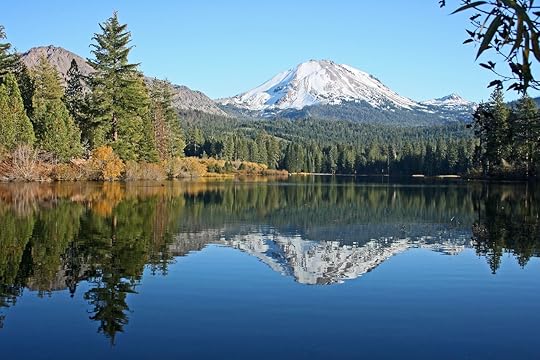
Photo: Malgorzata Litkowska/Shutterstock
Found in the Shasta Cascade region, Lassen Volcanic National Park does not get the recognition it deserves. It’s named after its signature volcano, Lassen Peak, the largest plug dome volcano in the world. Most of the national park is filled with hydrothermal features. These unusual and rare features are the most epic thing about Lassen.
A hike on the Bumpass Hell Trail will take you through Lassen’s largest hydrothermal area and give some up-close views of the boiling mud pots and superheated turquoise pools. The Sulphur works area is another prime spot to take a boardwalk hike through some volcanic gas vents, or fumaroles. By contrast, the other side of Lassen Volcanic National Park contains waterfall hikes and Manzanita Lake, a popular lake for kayaking, swimming, and camping. This area of the park provides visitors with views of Lassen Peak and lush forest hikes that connect to the Pacific Crest Trail.
Channel Islands National Park: wildlife
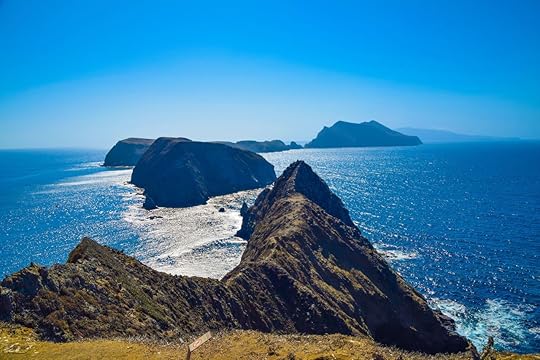
Photo: Carlos Gandiaga/Shutterstock
One of the most remote national parks in the US, Channel Islands is comprised of five islands off the coast of Southern California. The only way to reach them is via a plane or ferry departing from Ventura, Oxnard, or Santa Barbara. There are no facilities, electricity, or services on the islands. Even the park’s visitor center is on the mainland. While camping is available, everything brought onto the island must leave with you. This primitive atmosphere is the reason why the Channel Islands are an untouched wonderland. They are known as the Galapagos of North America, where wildlife teems. Naturally, this aspect of the islands is their most remarkable feature.
You can usually spot whales, dolphins, sea lions, seals, and marine birds while exploring the islands. Anacapa, the closest of the islands, is the most popular. It’s next to Santa Cruz, the largest of the islands. Hiking, kayaking, and snorkeling are among the top activities here. Tour companies offer rentals for those interested in kayaking, camping, or diving. And every trail leads you to some spectacular views of the Pacific Ocean and the island’s sea cliffs and caves. 

More like this: 15 US state parks that are just as epic as national parks
The post The best thing about each of California’s 9 national parks appeared first on Matador Network.

Guide to pintxos in Basque Country

Basque Country in northern Spain has long attracted anyone interested in trying some of the world’s most celebrated dishes. The region’s restaurants have earned around 30 Michelin stars, and one city, San Sebastián, has the highest concentration of Michelin-starred restaurants per capita in the world. Another unofficial capital of the autonomous Spanish Basque Country is Bilbao, which has a strong, centuries-old culinary presence as well.
But you don’t have to eat at a world-renowned restaurant to have a spectacular meal in Basque Country. Pintxos, small snacks similar to tapas, are served in nearly every tavern in the region, and indulging in a pintxo crawl is a fun way to jump into Basque culture and mingle with locals. As a tourist, you’ll mostly be left to fend for yourself, though there’s no reason to be shy about asking questions at the bar. And while there’s no wrong way to do a pintxos crawl, the best way is to follow what the locals do.
The difference between pintxos and tapas

Photo: alfernec/Shutterstock
It’s easy to confuse pintxos and tapas. While tapas are small portions of food served on plates, a pintxo (pronounced “peen-cho”) is a bite-sized snack served on a toothpick in Basque bars. Basque is the prominent language in the region, but the name pintxo comes from a colloquialization of the Spanish word pinchar, which means “to puncture,” as in puncture meats and vegetables with a toothpick. A small slice of bread is usually served alongside.Like tapas, pintxos are communal (while you don’t share a skewer, they’re often sold in multiples). You can expect to pay between $1.50 and $3.50 per pintxo.
Types of pintxos to choose from

Photo: alfernec/Shutterstock
It’s hard to eat just one pintxo. When you’re at the bar, you’ll see a display of room temperature pintxos you can choose and grab for yourself when you order a drink (depending on the bar as sometimes someone will serve you). Keep an eye out for a chalkboard showing the hot options that you can order from the bartender that will be cooked and brought out to you.
One of the more famous pintxos is the Gilda, which is made with olives, an anchovy, and a pickled pimento (speared on a toothpick, naturally). According to legend, it was created at Casa Vallés in San Sebastian in the 1940s and is named after the Rita Hayworth film Gilda. The pintxo is verde, salado, y picante, which was interpreted as “dirty, charming, and spicy” like Hayworth’s Gilda. Or so the story goes.
Other common options include octopus with smoked paprika that’s perfectly tender, never chewy, and garlicky prawn served with or without bread. Basque Country prides itself on high-quality seafood, but there’s also an abundance of mushroom, pork, and zucchini pintxos. If a bar has a particular pintxo it’s known for or has a special that day, it’ll likely be prominently advertised.
What to drink with pintxos

Photo: Sasa Padlocks/Shutterstock
Pintxos steal the show at Basque Country taverns, so choosing what to sip on is an easy task. January to the end of April is cider season, and they take their cider seriously here. Basque cider traditions include catching fresh cider right out of the barrel, and it’s as much fun to watch as it is to partake in. The cider is dry rather than sweet and pairs well with salty dishes.
The region is also known for txakoli (pronounced “chah-kuh-lee”), which is a dry, slightly sparkling white wine. It’s crisp and high in acid, making it the perfect accompaniment for a rich pintxo. If you like vinho verde, you’ll love txakoli.
For less alcohol, try the kalimotxo. This long drink is equal parts red wine and cola served over ice. It’s a surprisingly mild and refreshing combination. The cola calms the tannins in the wine while the wine balances out the sugar in the cola. Although it’s popular with teens, kalimotxos are served at nearly every bar, so you won’t look out of place ordering one.
How to order a pintxo

Photo: alfernec/Shutterstock
Be prepared for bars crowded with locals during the pre-dinner hours between 8:00 and 10:00 PM. Make your way to the bar and be assertive, but polite, when getting the bartender’s attention. You should know exactly what you want to order. If you seem indecisive, you’ll be passed over for someone who’s ready.
The rule of thumb is to order one pintxo per person and one glass of wine (or cider, etc). Repeat until you’re content or ready to move to the next bar. Always stay standing with your pintxo and drink, but be sure to move away from the bar to give others room to order. Take note that most places don’t offer seating at the bar.
After you’ve eaten your pintxos and used your napkin, ball it up and throw it on the ground. The idea is that it’s more sanitary on the ground than on the bar, especially if it’s crowded and the bartender hasn’t had time to clean up before the next guest arrives.
Don’t feel tied to one place. Bar hopping (or pintxo hopping) is common, and locals keep each bar visit around 20 minutes and make a point to enjoy the shop windows on their way to the next bar. If you’re stuck on which place you want to go next, there’s a good chance the bar with more napkins on the floor is the tastier option.
Tip: Locals rarely use plates, but tourists have been known to make a mini-meal out of pintxos, ordering three or four while sitting at a table to eat.
How to pay for pintxos
Pay for all of the pintxos and drinks together when you’re done and ready to leave. Simply go up to the bar and let the bartender know that you’d like the check. Some bartenders will tally your pintxos and drinks in their head — a true feat in today’s technology-reliant society. Other taverns count toothpicks while some have you tell them your exact order. If you’re in a larger group, it’s easiest to pay in a single check.
Tip: Tipping at bars is totally optional — feel free to round up to the nearest dollar and leave that as your tip. 

More like this: You’ll fall in love with Basque Country’s wild cider traditions
The post How to pintxo crawl through Basque Country like a local appeared first on Matador Network.

‘Dark Arts at Hogwarts Castle’ show

The dark side of Harry Potter’s wizarding world is about to come to live at Universal Studios Hollywood. From April 13 to 28, then again from May 25 to 27, the “Dark Arts at Hogwarts Castle” nighttime show will feature sinister imagery from the popular franchise covering the castle walls. Dementors, Death Eaters, Aragog the spider, Thestrals, and mountain trolls will be projected on the castle walls, with spectacular light, music, and other special effects.
The website promises “Dementors, Death Eaters and other unspeakable creatures [will] rise to cloak the stone walls in sinister images and fiendish magic. Chaos erupts as the image of Lord Voldemort joins the fray, summoning his cruel legions to swarm the castle. Experience the fire-engulfed army of Inferi and the soul-draining breath of Dementors as you stare in awe at the castle’s takeover.”
While details of the show have been out for a while, one surprising feature was just revealed by Attractions Magazine on Twitter. Universal will be employing flying drones in the form of a stag, Harry Potter’s Patronus, to presumably fight off the dementors. The amazing tech of flying drone imagery was recently made famous by Intel at the Pyeongchang Winter Olympics in 2018.
It looks like the new Dark Arts at Hogwarts Castle projection show will incorporate light-up drones forming Harry Potter’s Patronus. Here’s video by InstaMilo on Instagram of the @UniStudios show testing last night. Details on the show at https://t.co/0pmRedPSvz pic.twitter.com/79bPjwmDsC
— Attractions Magazine (@Attractions) April 3, 2019
“Dark Arts at Hogwarts Castle” isn’t just a visual spectacle, either. It will be accompanied by a surround-sound musical arrangement conducted by Williams Ross, based on original scores composed by John Williams. The villain-centric show will be a welcome change of pace for fans tired of always seeing the series’ heroes.
The Orlando version of the show will premiere later this year though dates haven’t yet been announced. 
H/T: Attractions Magazine

More like this: 11 insanely beautiful castles you can actually stay the night in
The post The ‘Dark Arts at Hogwarts’ show at Universal will feature flying drones in the shape of Harry’s Patronus appeared first on Matador Network.

Matador Network's Blog
- Matador Network's profile
- 6 followers



